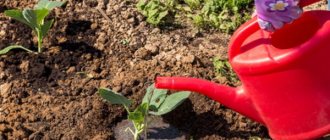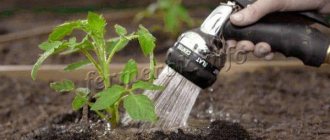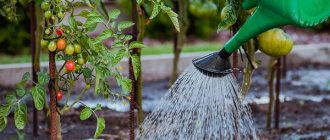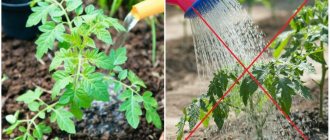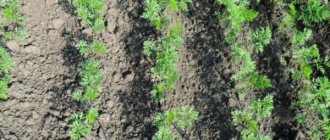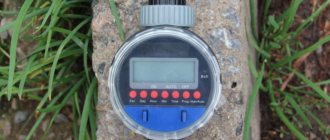Peppers are considered heat-loving plants, so most often they are grown in a greenhouse. But even in central Russia, many gardeners plant peppers in open ground and get a good harvest. The secret of success lies in proper watering of the pepper, which takes into account the fact that its roots are located close to the surface of the bed, so they require special conditions. How often to water peppers and how to do it correctly. We will answer these questions in this article.
General rules for watering peppers
For watering peppers in open ground, there are several general recommendations that should be followed to obtain a rich harvest:
- Use hole watering to ensure the roots receive the maximum amount of moisture.
- Water for irrigation should be at a temperature of +22 to +25 °C. Too cold a liquid can provoke the appearance of rot and fungus, while a hot liquid will slow down metabolic processes and become a favorable environment for the proliferation of pathogenic bacteria.
- When watering peppers from a hose or watering can, you need to use special nozzles. A powerful jet can damage the delicate root system.
- When watering, it should be done only on one side. On the other hand, it is necessary to carry out loosening. The next time you water, you need to change sides.
- Watering peppers in open ground is carried out in the morning so that some of the moisture can reach the root and the excess liquid has time to evaporate. If you water the crop during the day, drops of water that fall on the leaves can cause sunburn. Evening watering can cause waterlogging of the soil, as a result of which the lower part of the root will rot and the plant will die.
Well-loosened soil is important for peppers, so loosening is an integral procedure for moistening the beds. Gardeners advise watering the crop more often, but in less volume.
Important! In high humidity and rainy season, when the ground is always damp, the amount of watering should be reduced.
Watering methods
There are several watering methods:
- manual;
- mechanical;
- auto.
Each of them has its pros and cons. This makes it possible for the gardener to choose the most suitable one for the existing conditions and opportunities.
Manual
A familiar and accessible, but also the most time-consuming method. It is most often used in greenhouses where special irrigation systems are not installed, or in small garden plots. In open ground, you need to water in the morning, before sunrise, but you can also water it in the evening after sunset. Otherwise, the sun may burn the seedlings.
You can water from various containers: watering cans, buckets. You can use a hose to carry it from one bush to another. Peppers should not be watered from above with a large stream, but only under the bush, or with sprinkler irrigation.
Mechanical
The mechanical method of watering is convenient, but also requires human participation. The gardener will have to turn the system on and off, as well as control the watering. Due to the lack of automation, the cost of such equipment is low.
Auto
The most expensive option. This is a special system equipped with sensors and a control panel that performs watering automatically. For implementation, a constant source of electricity and water supply is required.
Did you know? Wealthy merchants were formerly called "pepper bags". This was considered an honorary title.
You will also need to lay pipes. It is better to use non-soft pipes so that they can withstand any water pressure. To install such a system, you need to carefully consider the project, since it is installed for a long time.
Irrigation systems are:
- Subsurface. It involves laying pipes underground. At the same time, it is quite difficult to regulate the uniform distribution of moisture over the area. The method is suitable for moisture-loving pepper varieties, so it is rarely used.
- Sprinklers. Imitation of rain. A lot of water is wasted. But after the method there is no need to loosen the soil. It cannot be used during the flowering period of pepper, as it washes off the pollen. Do not water under the sun to avoid burns. It creates excessive humidity in the greenhouse.
- Drip. To organize drip irrigation, pipes are placed on the surface near the rows of bushes with small holes, where the water will seep. For different soils, the recommended distances between holes may be different. So, for lighter soil, holes are made at 15–25 cm, for heavy loamy soil - 50–60 cm.
Drip irrigation is best for peppers. Economical water consumption. Using the drip method, you can not only water, but also apply fertilizing (this process is called fertigation). You can use any completely soluble fertilizer. Fertigation saves time on fertilizing. In addition, drip irrigation will deliver fertilizer directly to the root, which will increase its effectiveness and prevent the product from getting on the leaves and stems of plants.
The right water for watering peppers in open ground
For peppers, as for many other vegetable crops, cold water for irrigation can be disastrous. Beginning gardeners often take water for irrigation directly from a well or water supply, without taking into account its low temperature. Such a mistake could cost you your harvest. This does not mean that the water must be heated. It is enough to first leave it in a barrel or any other container for some time until it reaches an acceptable temperature, which should not be lower than +18 °C.
To increase the yield of sweet peppers, it is recommended to add additional nutrients to the water for irrigation. This can be done already 21 days after transplanting the seedlings. To prepare a nutrient solution, add urea (10 g) and superphosphate (5 g) to a bucket of water (10 l).
Plants with buds that have appeared need a cocktail with other ingredients - 3 tbsp. potassium per 10 liters of water.
After the first fruits begin to ripen, the plantings are fed with superphosphate (1 g) and potassium salt (1 g) diluted in 10 liters of water.
What water to use
Bell peppers and hot peppers are moisture-loving vegetable crops. For full growth and development, rapid rooting in the garden and good fruiting, the plant needs not only a sufficient amount of sunlight, but also moisture.
All pepper varieties tolerate drought very poorly. The plant has a shallow root system located close to the surface of the soil, so it is very important for the vegetable grower to carefully monitor the condition of the soil. At the same time, when growing peppers, it is necessary to take into account not only the optimal frequency of watering, but also the quality of the water used.
What water to use for watering peppers:
- To moisten peppers, you cannot use tap water - it contains chlorine and impurities of metal salts, which harm fragile seedlings.
- It is best to moisten peppers with rainwater, which has a softer composition without chemical impurities.
- If there is a river, pond or other fresh body of water nearby the garden, the water from it can also be used to irrigate the pepper beds.
The liquid for irrigation should not be cold, so it is not advisable to collect water from a well or borehole.
The optimal option is considered to be a temperature not lower than +17°C and not higher than +23°C. You don’t have to heat the water on purpose, but leave it in direct sunlight for several hours.
Frequency and abundance of watering peppers in open ground
During normal summer weather, peppers are watered a couple of times a week, but if weather conditions change - it becomes too hot or rainy - the amount of watering should be optimized.
Important! Per square meter of bed, the average liquid consumption is about 10 liters of water.
During the heat
Summer weather does not always please gardeners with stability. When the average daily temperature rises and the heat sets in, the peppers will need additional watering every two days. Before watering, it is imperative to loosen the bed, and in very dry weather, also the soil between the furrows. This measure will help the roots more easily take water from the adjacent soil in case of severe deficiency. How to determine the required volume of liquid? To do this, you need to carefully monitor the condition of the soil when watering - if a puddle begins to accumulate in the hole, the liquid no longer goes into the ground and is not absorbed, then you should stop watering.
Important! At air temperatures above +30 °C, before irrigation, the soil must be loosened throughout the entire bed where the peppers are planted.
In the rain and cold
Rainy weather, on the one hand, makes the work of gardeners easier, on the other hand, it increases the risk of fungal diseases. If precipitation is heavy and frequent, then additional watering of peppers in open ground will not be required.
How to determine whether a crop has enough moisture for good growth
To determine how often to water pepper seedlings on the windowsill, you need to learn how to determine whether the seedlings have enough water.
If the seedling box has a large volume of soil, then the water from it does not evaporate so quickly, so frequent watering is not required. Small containers dry out faster and require constant monitoring.
Daily check of seedlings on the windowsill:
- if the soil mixture has dried to a depth of 2-4 cm, then it can be moistened;
- There is no need to water the wet soil mixture.
You can also take some soil from the pot and roll it into a ball. If the soil is rolled up, there is no need to water; if not, it is worth moistening the soil.
Features of watering at different periods of pepper development
Peppers go through several stages of growth and development during the season, each of them has its own requirements for watering and feeding. To get a good harvest, you need to monitor what stage the pepper is currently going through in order to provide it with the most comfortable conditions for growth and abundant fruiting.
Shoots (at planting)
Pepper seeds, as a rule, are planted in separate cups and are not watered at first, as they are covered with film to retain moisture. When seedlings appear, they are watered as the soil dries. If the seeds were planted in a common container, then the sprouts are carefully moistened before picking.
You can pick seedlings when the seedlings, in addition to the cotyledons, have two more true leaves ranging in size from 3-5 mm to 2 cm; in the first case, the root system has not yet branched, but closer to the second it is highly branched. You need to constantly water the seedlings after picking and before planting them in the ground; the lump of earth should not dry out, but should not be soggy either.
If your seedlings begin to turn yellow, the most common reason for this is improper watering. The soil should have time to dry, do not overwater the peppers, water once every two days, not more often. Also, do not forget that the water should be warm, preferably melt or rain, but always separated from chlorine. If everything is in order with watering, check other aspects of caring for seedlings, namely, good drainage near the containers and draining the water accumulated in the pan. If this does not help, check the roots of the seedlings:
- Rotten - add Fitosporin or Trichodermin to the soil. Alternatively, you can pour it with an intense pink solution of potassium permanganate.
- There is no rot - feed with nitrogen. But be careful, nitrogen causes rapid growth, the seedlings should not overgrow.
We also recommend spraying pepper with Epin, it will boost immunity. It can be used one day before planting seedlings in open ground, this will increase their survival rate.
By the way, pepper seedlings can be grown using wick irrigation; it is done as follows: the plant is planted in the upper part of a plastic bottle cut in half, water is poured into the lower part and both halves of the bottle are connected with a wick from a clothesline.
Pepper seedlings should be planted in open ground during the daytime period when sun activity is minimal, for example, in the evening.
Cloudy or cloudy weather is also suitable for planting. Planting is carried out in several stages:
- Holes of the required size are dug in advance, and specialized fertilizer is added there in accordance with the attached instructions.
- Each seedling bush is placed in a separate hole, which is filled 75% with soil.
- Fill another 10% of the hole with fertilizer for peppers.
- The seedlings are watered.
- The remaining space in the hole is covered with earth.
Young plants need to be watered much less often than adults. After transplanting peppers into open ground, the next watering should be done no earlier than 2 days later. But you need to rely on weather conditions.
Before the first inflorescences appear, the peppers will need only once weekly watering. But if the weather is very hot outside, then you need to water more often, sometimes the frequency of watering increases to 3 times a week
Important! Whatever the temperature outside, the water for irrigation should always be a few degrees warmer than room temperature.
During and after flowering
As soon as the peppers begin to bloom, they need to be watered 3 times a week. Experienced experts advise using it for sufficient moisture per 1 square meter. m of plantings about 10 liters of water. But, again, you need to focus on weather conditions.
During flowering, it is very important to monitor the temperature of the water used for watering peppers in open ground. If you notice that the flowers develop poorly and fall off before they have time to form, then you need to check whether you are moistening the beds with too much cold water.
During fruiting
During and after fruit set in peppers, the volume of water for irrigation should be reduced. Irrigation of plantings is carried out no more than twice every 7 days. Experienced gardeners vary the taste of future peppers using water of different temperatures. For the peppers to turn out sweet, it must be warm. If you want to get a harvest with a piquant bitterness, you can take cool water.
Important! You need to water the peppers so that the stream from the watering can hits the base of the bush directly and does not injure the inflorescences and ovaries.
Care after watering
Proper care after watering will help prevent rapid evaporation of moisture and maintain optimal moisture balance for a long time. The most important thing is mulching after irrigation.
Peat, straw, sawdust, fallen leaves or chopped grass can be used as a mulch layer. An excellent option would be a special non-woven material - spunbond or agrofibre.
The mulch layer (except for non-woven material) should have a thickness of 5-7 cm. Next time, the pepper can be watered directly on top of the mulch. Another advantage of mulching is weed control, so after laying the mulch, peppers will need to be weeded much less frequently.
After each watering, as well as rain, the soil around the pepper must be loosened. This will prevent the appearance of a hard crust on the surface of the earth, which impairs the access of oxygen to the roots of the plant. But loosening must be done very carefully, since pepper has a superficial root system - that is, located close to the surface of the soil.
Features of watering peppers in combination with fertilizers
Peppers planted in open ground need not only proper watering, but also regular feeding. Nutrients are especially needed during the period of active flowering; peppers need calcium, nitrogen, phosphorus and potassium most of all at this time. These substances are also present in the soil in minimal dosages, but, as a rule, they are not enough for the normal development of the crop. Therefore, it is so important to additionally feed the plantings. They are carried out in the following sequence:
- Fertilizer for peppers is purchased in a specialized store and diluted in accordance with the instructions, after which it is placed near each bush.
- 30 minutes after applying the fertilizer to the soil, it should be watered with a small amount of warm water (from +22 to +30 °C).
- After 40-60 minutes, the bed is watered again, but this time abundantly.
Peppers do not tolerate fertilizers containing chlorine, which inhibits the root system of plantings.
During flowering, feed plants with nitrogen-containing fertilizers, and during fruiting, use fertilizers with potassium and calcium.
Important! To obtain a large number of juicy and tasty fruits, it is recommended to fertilize peppers once every 2 weeks.
A lack of nutrients has a detrimental effect not only on the amount of harvest, but also on the appearance of the plantings themselves. Numerous signs can signal a deficiency of various micro- and macroelements. We have listed them in the table below.
| Signs | An element that peppers need | How to fix the problem |
| The leaves on the reverse side acquire a gray tint and become dull. | Nitrogen | The bases of the plantings are periodically sprayed with nitrogen-containing fertilizers, for example, urea. |
| The ovaries fall off before they have time to form, and the fruits wither and do not grow. | Bor | Water the plantings with a substrate prepared from boric acid and water 1:10. |
| Pepper leaves begin to turn yellow. | Iron | Feed with iron sulfate or an aqueous solution of Ferovit. |
| Fruit growth is extremely slow, they do not ripen. | Phosphates | Reduce the amount of nitrogen-containing fertilizers applied and start feeding the peppers with a solution containing superphosphates (4 tbsp per 10 l). |
| Stunted growth, large unevenly scattered spots on the leaves. | Manganese | Treat with a 1% solution of manganese sulfate two to three times a week. Can be incorporated into the soil at a rate of 5-10 g/sq.m. m. |
| Deformation of young leaves, appearance of yellow spots. | Calcium | Grind several shells in a coffee grinder or blender and sprinkle the ground under the bushes. |
Green fertilizer for peppers! Take a 10 liter bucket, fill 1/3 with green grass (greens) with a small bunch of hay, add 1 liter of compost or fertile soil, fill it with water and mix. Cover the bucket with a lid and leave to infuse for 5 days. Stir the fertilizer every day. After a liter, dilute it in 10 liters of water and feed the pepper.
Watering with fertilizing
Watering bell or hot peppers can be combined with the simultaneous application of fertilizing. This will help not only moisturize the plants, but also saturate them with the mineral elements necessary for full growth, development and good fruiting.
Irrigation options with fertilizing:
- 18-22 days after planting peppers in open soil - 2-3 grams of superphosphate and 5 grams of calcium nitrate per 5 liters of water.
- The period of bud formation is ½ teaspoon of liquid mineral fertilizers with a high potassium content per 5 liters of water.
- Completion of fruit filling - 0.5 grams of potassium salt and superphosphate per 5 liters of water.
Among organic fertilizers, it is best to use peat or wood ash. They are added in an amount of 10 g or 1 tsp. per 1 liter of water, respectively.
To stimulate the growth of young seedlings and their rooting, you can use hydrogen peroxide, which can be found in any home medicine cabinet. To do this, add 2 tbsp to 1 liter of water. l. peroxide with a concentration of 3%. For each seedling you will need a teaspoon of this stimulant, which is applied under the root in the early morning or evening.
When to stop watering peppers by region (table)
The optimal length of daylight hours is 12 hours. It is from this indicator that one must proceed when calculating the volumes and number of irrigations. In the table below we have given indicators of daylight hours for different parts of Russia, depending on their geographical location.
| Geographical position | March | April | May | June | July | August | September | October |
| North | 8.5 | 12 | 15 | 17.5 | 18 | 16 | 15 | 12 |
| Center | 9 | 11 | 14 | 16 | 17.5 | 17 | 14 | 12 |
| Siberia, middle part* | 10 | 12.5 | 17 | 21 | 20 | 18 | 11 | 7 |
| Far East, middle part* | 11 | 14 | 18 | 21 | 20 | 17 | 13 | 9 |
| South | 11.5 | 13.5 | 15 | 16 | 16 | 14 | 13 | 10 |
*Refers to regions between 65 and 55 degrees north latitude.
In addition to the length of daylight hours, you also need to take into account the air temperature. It is best to water when the thermometer is in the range from +18 to +25 °C.
How many days after planting the seeds does pepper sprout?
Photo source: percevod.ru
When peppers emerge from the moment the seeds are planted depends on the air temperature. If the soil is well moistened, sprouts will appear through:
5-10 days – if the air temperature is +25-29 degrees; 2-3 weeks – if the air temperature is +23-25 degrees.
If the temperature is less than +21 degrees, the seedlings rot and die.
Possible methods of watering peppers in open ground
Watering is an integral part of the normal growth and development of peppers, but it must be done correctly in compliance with all necessary recommendations. There are several methods of soil irrigation that every gardener can use for his plantings.
Drip irrigation
Ideal for those gardeners who visit the plot only on weekends. The system can be purchased at a store, or you can install it yourself using available materials. For drip irrigation, you will need a large container to hold the water, unless it is directly supplied from the water supply. In addition, this system can be supplemented with a timer, which will regulate the frequency and volume of watering according to the parameters you set. This method has a number of undeniable advantages:
- The soil will be moistened evenly, which will eliminate the formation of a crust and reduce the need for loosening.
- The roots will receive a sufficient amount of moisture and will be able to absorb nutrients from the soil in the right quantities, which will allow them to fully develop.
- Drops of water are prevented from getting on the leaves; only the roots and the soil around them are moistened.
- Water is used economically.
- The number of weeds is reduced.
Surface watering
Such irrigation is carried out in hot regions so that a significant supply of water remains in the soil. To do this, furrows or square holes are formed around the plantings. Thus, the moisture does not go far from the root and is not wasted, and the roots absorb it as needed. The main thing is to make sure that the peppers do not stand in a puddle, otherwise root rot may appear. Surface watering requires gardeners to spend a lot of money on preparatory work, but gives good results in the form of active crop growth and a large amount of harvest.
Fine watering or sprinkling
This type of irrigation is relevant either in very modest areas, or, conversely, when processing plantings on an industrial scale. In simple terms, dispersed irrigation is spraying plants. For a small number of peppers it can be carried out with a regular hand sprayer. If the volume of work is large, then special sprinkler installations are purchased and installed.
This method of watering is used to cool the bush and accelerate photosynthesis processes. It cannot be used as an independent watering in hot regions, otherwise the incoming liquid will not be enough for the roots and the plant will die.
Subsoil irrigation
Subsoil irrigation is relevant for a large area of land planted with different crops. Sometimes it is also installed by those gardeners who go to the hacienda only a few times a month. This method is quite labor-intensive and expensive.
Before forming the bed, special pipes are laid in the ground, from which water flows into the ground in a given mode. In addition to the uniform distribution of liquid, there is another advantage - there is no need to regularly loosen the beds before watering.
Manual watering
Most gardeners in Russia still use manual watering. All kinds of containers are used for it (watering cans, buckets, ladles). The method is long and physically difficult, suitable for a small planting area.
But its advantage is the ability to regulate and control the water temperature. Sometimes a hose is used for manual watering, but it is necessary to put a special tip on it so that the powerful stream does not damage the delicate roots.
What types of irrigation are used
Watering sweet peppers in a polycarbonate greenhouse is carried out in different ways.
We indicate them in the table.
| View | How does it work |
| Auto | Switching on and off is automatic; switching on and off the water supply is carried out using sensors set for a certain time. A remote control or a centralized power supply is used for control. |
| Mechanical | Less perfect. It will be necessary to ensure a constant supply of water to the system. You will need to adjust the water pressure yourself. Correct connection to a water source (well, borehole, centralized water supply system) will allow you to obtain an automated water supply that does not require careful monitoring and manual adjustment. |
| Manual | This is done using buckets, watering cans or a hose connected to a water source. When using a hose, it is advisable to use a dispersive nozzle, because You can wash the roots with water pressure. All work is done manually |
The most rational option is to use an automatic system. During the preparation process, you will need to calculate the plant’s daily moisture requirement at a certain stage of development.
This question is quite important, since there are several options for adding water during automatic irrigation:
- drip;
- sprinkling;
- intrasoil.
The requirements for the quality of pipes and models of nozzles depend on the chosen option. For watering peppers and seedlings, subsurface irrigation is rarely used, because not all varieties are particularly moisture-loving, and excess moisture can negatively affect the development of plants.
The use of a drip system provides undeniable advantages; it is more economical in terms of water consumption, which is supplied directly to the roots of the plant. Excessive air humidity, which is observed during sprinkling, can lead to the development of fungal diseases.
Let's watch a video on how to make drip irrigation in a greenhouse with your own hands:
Features of watering bell (sweet) and hot peppers
You will only get full fruits of sweet and bitter peppers if you plant them as far apart as possible. Otherwise, mixing will occur during the pollination process, and the resulting peppers will have the same taste.
- It is recommended to water bell peppers more often, but less, so that the roots absorb sugar. If you water too much, the roots may begin to rot.
- Hot peppers are watered less often so that they do not pick up microelements from the soil that affect the formation of sugar notes.
Combining fertilizing bell pepper with watering
Soil poor in nutrients and minerals will not allow for a rich harvest. Therefore, systematic feeding of plants should be carried out, which can be combined with watering.
You can apply complex mineral fertilizers, infusions of mullein or herbs. Addiction to organic fertilizers can lead to excessive growth of green mass and branching of bushes, but to the detriment of yield. Both foliar and root fertilizers are used.
What are the dangers of excess or lack of moisture for peppers (consequences of improper watering)
Peppers must be watered strictly according to the rules, focusing on weather conditions, day length and soil quality. Excess moisture can lead to harmful consequences:
- Fall of flowers and ovaries. If too much liquid gets into the soil, it becomes very dense, the aeration process and the ability of the roots to absorb useful microelements are disrupted. Too few of them reach the ovaries for their normal formation.
- The appearance of fungal diseases. The first sign of rot is dark spots on the leaves, then the base of the stem may begin to rot, which will inevitably lead to the death of the bush. The disease progresses especially intensively with excess moisture in cloudy weather.
- Invasion of slugs. These pests love moist soil. Overfilled soil can attract uninvited guests who will happily feast on juicy fruits and pepper leaves.
- Sunburn. As a result of excessive intensive watering, drops of liquid may remain on the leaves, which in hot weather can lead to sunburn.
When watering peppers, it is important to remember that the danger for plants is not only too much watering, but also its insufficient volume. In this case, the first thing to do is to dry up the ovaries of the flowers, and the fruits turn out deformed and small.
If there is a lack of liquid, bell peppers will produce bitter fruits, and chili peppers will begin to have spots on their pods.
Factors on which pepper yield depends
The success of growing any crop cannot depend on one factor, but watering sweet peppers in a greenhouse can be considered one of the most important components of care.
The second factor is air humidity, which largely depends on the frequency of moisture application, the material from which the greenhouse is made and the quality of ventilation.
Too moist soil and air will also negatively affect the development of the plant itself and its yield, and increase the risk of developing fungal diseases.
Tips from Mister Summer Resident
Our website https://mrdachnik.com has several tips that will help you harvest an excellent harvest at the end of the season:
- Peppers love loose soil, so at the slightest hint of crust formation, the bed should be loosened immediately.
- To improve the quality of watering, you need to form a hole near the bush, filling it with mulch on top.
- If the soil is very dense and sticky, then the amount of watering should be reduced.
- If you doubt the required volume of water, be guided by the fact that a puddle appears - as soon as the water stops going deeper, you should stop watering.
- Tap water needs to settle for a day to avoid chlorine getting into the ground.
- If the water has a high level of hardness, ash should be added to it at the rate of 0.5 tbsp. for 10 l.
- Peppers need additional irrigation and spraying, but not in the heat or during prolonged rains.
- Water for irrigation should be warm - from +22 to +25 °C. To achieve the desired temperature, you can leave the container with liquid in the sun to heat up, or dilute ice water with hot water.
- Sandy soil must be additionally compacted with peat or compost, and the peppers planted in it must also be mulched to better retain moisture.
Rules for irrigation in a greenhouse
Pepper is a vegetable crop that prefers moist soil. If the soil dries out, flowers fall from the plant, resulting in a decrease in yield.
Irrigation timing
Pepper loves water. The frequency and timing of irrigation depend on the climatic conditions of a particular area.
Many people believe that during the rains there is no need to water peppers. This opinion is wrong. Even during this period, plants need high-quality irrigation, unless, of course, prolonged rainfall occurs in the area.
It is recommended to water the plants in the evening, then leave the greenhouse open for an hour for ventilation.
Water requirements
One of the common mistakes novice gardeners make is watering peppers with cold water. It is strictly prohibited to water the plant with such water. The water temperature should be 23-25°C.
It is recommended to fill the tank with water, leave it to bask in the sun, and then water the plants.
Irrigation frequency
As soon as the first shoots appear on the seedlings, the plant must be irrigated every 2-3 days.
After planting the seedlings in the greenhouse, water it abundantly.
Reference. Abundant irrigation should not harm the bush. Be careful not to let the plant squint while watering.
After this, watering is repeated every other week.
Despite all the recommendations for watering, pay attention to the soil. It should always be moisturized. If the soil is dry, the plant will grow poorly, the leaves will turn yellow, and the fruits will lose their juiciness.
Also make sure that the soil is not waterlogged. This is bad for the plant and can lead to rotting of the basal stem or rhizome.
When and how to water peppers
After transplanting pepper seedlings to a permanent place, the dosage of watering is gradually increased as the plant grows - from 0.5-1 liters to 4-5 liters per bush.
It is very important to provide moisture to peppers during flowering and at the beginning of fruit formation.
But when the fruits begin to turn a different color (ripen), the amount and frequency of watering is reduced.
Watering sweet peppers in a glass greenhouse
When making a glass greenhouse yourself, you should give preference to glass whose thickness exceeds 5 mm. The features of this material make it possible to create a design that does not provoke the accumulation of condensation on the walls.
Uniform distribution of moisture throughout the entire volume of the greenhouse allows you to reduce the number of waterings and achieve significant water savings. Thanks to these features, glass greenhouses are very popular among summer residents.
Watering sweet peppers in a greenhouse after planting seedlings varies depending on the stage of plant development. When planning plant care, we should not forget that excess moisture for bell peppers can be just as harmful as its lack.
Watering potatoes
How much water do potatoes need?
After planting and before sprouting, potatoes do not need to be watered.
An excess of moisture during this period does not allow the plant’s root system to develop. The first watering of potatoes is necessary approximately 3-5 days after emergence, and 2-3 liters of water should be poured under one bush.
During flowering, when tubers are set, potatoes especially need watering. One abundant watering during flowering is enough to increase potato yield by 20-30%. The rate of water consumption per bush during this period is 3-5 liters.
When and to what depth to water potatoes?
Ideally, there should be enough water to wet the soil under the potato bush to a depth of 15-20 centimeters.
In June, if the weather is hot, it is recommended to water the potatoes late in the evening.
In the second half of summer, potato beds can be watered both in the evening and early in the morning with warm water that has settled in barrels.
With the onset of September, there is no point in watering potatoes. Watering is completely stopped 5-7 days before tubers are harvested.
Tips and tricks
To ensure a rich harvest, follow the advice of experienced gardeners:
- If a crust has formed on the surface of the soil, loosen the soil to achieve uniform moisture in the root zone. It is best to make a small funnel around the plant and mulch it.
- If the soil is sticky and dense, take a break from watering for a few days.
- To avoid ruining the crop with excess moisture, loosen the soil around the peppers and then water them. If puddles appear and moisture no longer flows to the roots, stop watering.
- Leave chlorinated tap water for 24 hours. If the water is too hard, add wood ash - half a glass per bucket of liquid.
- Even in rainy weather, do not forget about irrigation. The exception is prolonged and heavy rainfall.
- The optimal water temperature for irrigation is from 22 to 25°C. You can dilute well water with heated water or collect moisture from containers left in the sun.
- If the soil contains a lot of sand, moisture is practically not retained in it, so you have to water the crop more often. To improve the quality of the soil, add compost or peat to it and do not forget to mulch the plants.
